
5 ancient grains transforming Indian cuisine
What's the story
Ancient grains have been a part of Indian cuisine for centuries, providing nutritional benefits and unique flavors. These grains are making a comeback in modern diets as people look for healthier, more sustainable food options. From millets to barley, these grains are versatile and can be used in a variety of dishes, including the traditional Indian thali. Here's how these ancient grains are transforming Indian cuisine.
#1
Millet: The versatile grain
Millet is a staple in many parts of India. It is drought-resistant and grows well in arid regions. Rich in fiber, magnesium, and antioxidants, millet can be used to make rotis, dosas, or even desserts. Its nutty flavor goes well with both savory and sweet dishes. Adding millet to the thali not only enhances its nutritional value but also supports sustainable agriculture.
#2
Barley: The fiber-rich grain
Barley is another ancient grain that is packed with soluble fiber, which helps in digestion and lowers cholesterol levels. It is mostly consumed as a porridge or added to soups and stews. Barley's mild flavor makes it a great addition to the thali, providing texture without overpowering other ingredients. Its low glycemic index also makes it a great option for diabetics.
#3
Quinoa: The protein powerhouse
Quinoa has gained immense popularity for its high protein content and all nine essential amino acids. Though not native to India, it is widely cultivated in some parts of the country now. Quinoa can be used as a rice substitute or added to salads and pilafs on the thali. Its versatility and nutritional benefits make it an ideal choice for those looking for plant-based protein sources.
#4
Amaranth: The nutrient-dense seed
Amaranth is often mistaken for a grain but is actually a seed from a flowering plant. It is rich in iron, calcium, potassium, and vitamins A and C. Amaranth flour can be used to make gluten-free bread or pancakes on the thali. Its slightly sweet taste complements spicy curries or tangy chutneys perfectly.
#5
Sorghum: The drought-resistant grain
Sorghum, which is native to Africa but also widely grown in India, is perfect for dry climates as it requires little water. It is packed with protein, fiber, iron, phosphorus, and B vitamins. Sorghum flour can be used for baking bread or thickening soups on the thali. Its mild sweetness balances spicy dishes, making it a great addition to any meal.